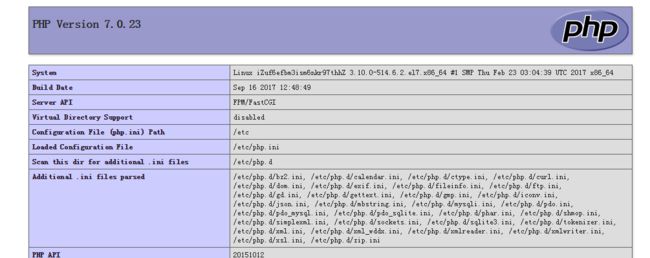注:为了方便说明,下面部署的这台服务器的ip为127.0.0.1,实验时请使用自己真实的ip
一 【nginx 安装】
参考官方文档 : http://nginx.org/en/linux_packages.html#stable
具体步骤
1.新建文件:vim /etc/yum.repos.d/nginx.repo
2.编辑并保持如下内容:
[nginx]
name=nginx repo
baseurl=http://nginx.org/packages/centos/7/$basearch/
gpgcheck=0
enabled=1
可以使用 vim /etc/yum.repos.d/nginx.repo 来编辑,也可以是用其他文本编辑工具
3.使用yum安装
yum remove nginx
yum install nginx
yum remove nginx , 是为了有旧的nginx,先卸载
二 【php7,php-fpm 安装】
具体步骤:
1.安装epel-release源
rpm -Uvh https://dl.fedoraproject.org/pub/epel/epel-release-latest-7.noarch.rpm
2.安装PHP7的rpm源
rpm -Uvh https://mirror.webtatic.com/yum/el7/webtatic-release.rpm
webtatic-release.rpm 依赖于 epel-release-latest-7.noarch.rpm
3.安装php7
yum remove php*
yum install php70w
yum remove php* 是为了卸载旧版本的php相关软件,不然如果版本不兼容可能会报下面错误:
 image
image
4.安装php相关扩展
yum install php70w-fpm php70w-mysql php70w-xml php70w-mbstring php70w-openssl php70w-gd
yum install php-redis #redis模块,根据需要选装
php70w-fpm : FastCGI进程管理器
因为php是以FastCGI方式运行的,当用户访问.html等静态页面的时候,nginx直接返回静态页面。当访问.php文件时,nginx会把处理权交给php-fpm,当对.php文件解释执行完成后,把执行结果返回给nginx,再由nginx返回给用户。
php70w-mysql:php操作mysql数据库扩展
php扩展很多,一般根据名称就能知道具体用处,就不多解释了。
centos8中不能用dnf和yum安装redis扩展的解决办法
$ wget https://github.com/phpredis/phpredis/archive/4.0.2.tar.gz
$ tar -zxvf phpredis-4.0.2.tar.gz
$ cd phpredis-4.0.2
$ /usr/local/php/bin/phpize # php安装后的路径,如果没有请用(yum install php-devel命令)
$ ./configure --with-php-config=/usr/local/php/bin/php-config
$ make && make install
echo 'extension=redis.so' >> /usr/local/php/etc/php.ini
systemctl reload php-fpm
大功告成
三 【安装mysql】
yum -y install mariadb-server mariadb mariadb-devel
MariaDB是MySQL的一个开源分支,基本可以和MySQL通用。
mariadb-server : 服务器端
mariadb : 命令行客户端
mariadb-devel : 开发库
四 【启动相关服务】
1.启动nginx服务
systemctl start nginx.service
2.启动php-fpm服务
$ sudo systemctl start php-fpm# 启动php-fpm
$ sudo systemctl stop php-fpm# 停止php-fpm
$ sudo systemctl reload php-fpm# 重载php-fpm
$ sudo systemctl restart php-fpm# 重启php-fpm
systemctl start php-fpm.service
3.启动mysql服务
systemctl start mariadb.service
> 使用 netstat -tnl 命令查看,如果80,9000,3306端口都已经被监听,说明nginx,php-fpm,mysql服务都已经启动成功,如图:
>
> 
>
> 在服务器防火墙能通过的情况下,在浏览器里地址栏里输入: http://106.15.72.29/,如果出现下图界面,表示nginx已经工作正常,恭喜您,网站可以访问静态页面了。
>
> 
>
> 如果要访问php动态页面 ,请继续往下看。
#### 五 【nginx配置】
1.打开 /etc/nginx/conf.d/default.conf ,在最上面添加如下代码并保存:
server {
listen 80;
server_name www.test.com;
client_max_body_size 64M;
error_page 500 502 503 504 /50x.html;
root /opt/web/imapp;
try_files $uri $uri/ @rewrite;
location @rewrite {
rewrite ^/(.*)$ /index.php?_url=/$1;
}
location ~ \.php {
fastcgi_pass 127.0.0.1:9000;
fastcgi_index index.php;
fastcgi_param SCRIPT_FILENAME $document_root$fastcgi_script_name;
include fastcgi_params;
fastcgi_split_path_info ^(.+\.php)(.*)$;
fastcgi_param PATH_INFO $fastcgi_path_info;
}
}
1.server_name www.test.com; 这里的www.test.com可以根据自己的域名解析修改,当域名解析后,可以根据不同的域名访问不同的server站点
2.root /opt/web/imapp; 这个是当前server站点的主目录,可以把php代码都放到这个目录下,请自行修改。
3.这里还做了去index.php的配置,可以将 http://127.0.0.1/index.php/user/login 简化为 http://127.0.0.1/user/login,有兴趣请自行研究。
2.重新加载配置文件
systemctl reload nginx.service
3.在/opt/web/imapp目录下新建一个test.php文件,编辑php代码并保存
4.访问地址:
http://106.15.72.29/test.php
如果出现下图,php页面执行成功
 image
image恭喜您,网站可以访问php动态页面了,环境搭建完成。
六 【服务进程的管理维护】
1.查看nginx服务状态
systemctl list-unit-files --type=service | grep nginx
 image
image
2.查看nginx的运行状态
systemctl status nginx.service
 image
image
3.设置nginx服务开机启动
systemctl enable nginx.service
4.设置nginx服务开机不启动
systemctl disable nginx.service